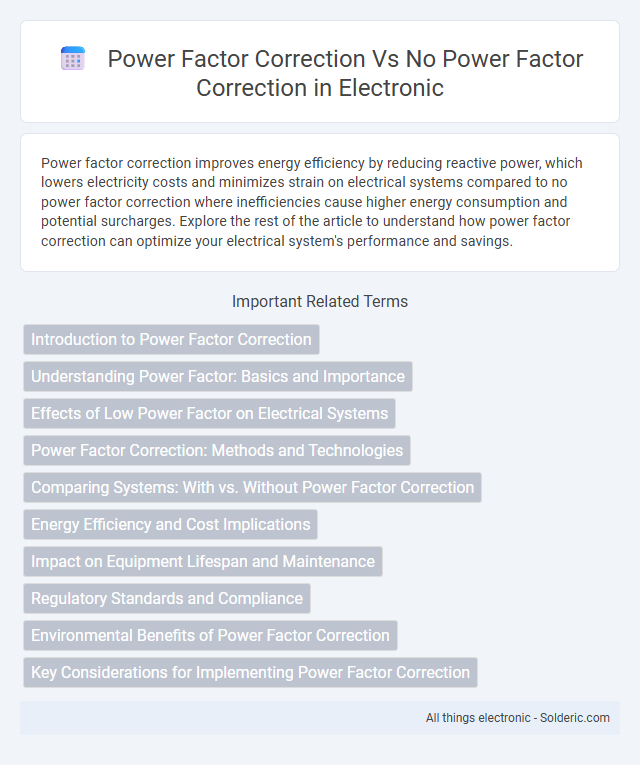Power factor correction improves energy efficiency by reducing reactive power, which lowers electricity costs and minimizes strain on electrical systems compared to no power factor correction where inefficiencies cause higher energy consumption and potential surcharges. Explore the rest of the article to understand how power factor correction can optimize your electrical system's performance and savings.
Comparison Table
| Aspect | Power Factor Correction | No Power Factor Correction |
|---|---|---|
| Power Factor | Improved (close to 1.0) | Low (typically 0.7 to 0.9) |
| Electricity Efficiency | Enhanced, less reactive power loss | Reduced due to higher reactive power |
| Energy Costs | Lower, reduced demand charges | Higher due to penalties and inefficiency |
| Equipment Lifespan | Extended, less overheating and stress | Shortened, increased wear and tear |
| Capacity Utilization | Optimal, more available load capacity | Suboptimal, higher apparent power demand |
| Voltage Stability | Improved voltage regulation | Voltage drops and fluctuations |
| Environmental Impact | Lower CO2 emissions due to energy savings | Higher emissions from wasted energy |
Introduction to Power Factor Correction
Power factor correction improves the efficiency of electrical systems by reducing reactive power and minimizing energy losses, resulting in lower electricity bills and enhanced equipment performance. Without power factor correction, your system experiences higher current draw, increased heat, and potential penalties from utility companies due to poor power quality. Implementing power factor correction optimizes energy usage, prolongs equipment lifespan, and drives cost savings in industrial and commercial settings.
Understanding Power Factor: Basics and Importance
Power factor correction improves the efficiency of electrical systems by aligning voltage and current waveforms, reducing reactive power and minimizing energy losses. Without power factor correction, systems experience higher utility charges due to increased apparent power demand and suffer from reduced equipment lifespan caused by overheating and inefficiencies. Implementing power factor correction enhances overall system performance, reduces operational costs, and contributes to more stable grid management.
Effects of Low Power Factor on Electrical Systems
Low power factor causes increased current flow, leading to higher energy losses, overheating of equipment, and reduced system capacity in electrical installations. Without power factor correction, your utility bills rise due to inefficient energy use and possible penalties from power companies. Implementing power factor correction optimizes voltage stability, minimizes energy waste, and extends the lifespan of electrical components.
Power Factor Correction: Methods and Technologies
Power factor correction improves energy efficiency by reducing reactive power through methods such as capacitor banks, synchronous condensers, and active power filters. These technologies enhance electrical system performance by minimizing losses, lowering utility penalties, and optimizing load management. Without power factor correction, electrical systems experience increased energy waste, higher operational costs, and potential equipment strain due to poor power factor levels.
Comparing Systems: With vs. Without Power Factor Correction
Power factor correction improves energy efficiency by reducing reactive power, leading to lower electrical losses and decreased utility charges compared to systems without correction. Without power factor correction, your electrical system experiences higher current flow, increased heat generation, and potential penalties from energy providers due to poor power factor values below 0.9. Implementing power factor correction devices stabilizes voltage levels and enhances overall equipment performance, reducing operational costs and extending the lifespan of electrical components.
Energy Efficiency and Cost Implications
Power factor correction improves energy efficiency by reducing reactive power, which lowers overall energy consumption and decreases utility charges based on apparent power usage. Without power factor correction, your system experiences higher losses and increased demand charges due to inefficient energy flow, leading to greater operational costs. Investing in power factor correction results in optimized electrical system performance and significant cost savings over time.
Impact on Equipment Lifespan and Maintenance
Power factor correction improves equipment lifespan by reducing electrical stress and overheating caused by reactive power, leading to fewer breakdowns and extended maintenance intervals. Without power factor correction, your equipment is subjected to higher current flow and voltage drops, accelerating wear and increasing the frequency of repairs. Implementing power factor correction enhances overall system efficiency, lowering maintenance costs and prolonging the operational life of electrical components.
Regulatory Standards and Compliance
Regulatory standards such as IEEE 519 and IEC 61000-3-2 require power factor correction to minimize harmonic distortion and improve energy efficiency, ensuring compliance with grid codes. Without power factor correction, facilities risk penalties, increased energy costs, and potential equipment damage due to poor power quality. Implementing power factor correction helps your system meet mandated power quality standards and avoid regulatory non-compliance issues.
Environmental Benefits of Power Factor Correction
Power factor correction reduces energy losses in electrical systems by improving the efficiency and stability of power usage, leading to decreased greenhouse gas emissions and lower carbon footprints. By minimizing reactive power draw from the grid, it lessens the demand on power plants and reduces the need for additional energy production from fossil fuels. This optimized energy consumption contributes to more sustainable electricity networks and supports environmental conservation efforts.
Key Considerations for Implementing Power Factor Correction
Power factor correction improves energy efficiency by reducing reactive power, lowering utility charges, and enhancing voltage stability in electrical systems. Without power factor correction, your equipment may experience increased losses, overheating, and potential penalties from utility providers due to low power factor levels. When implementing power factor correction, consider the type of load, desired power factor target, cost of equipment, and ongoing maintenance requirements to optimize system performance and reduce operational costs.
power factor correction vs no power factor correction Infographic

 solderic.com
solderic.com